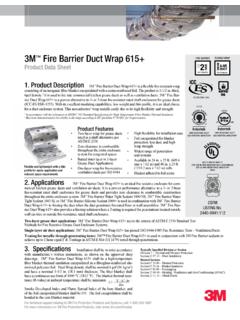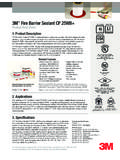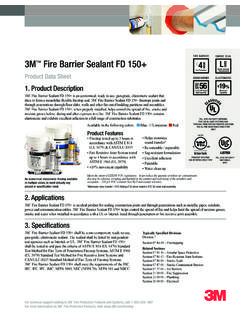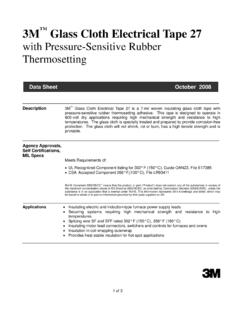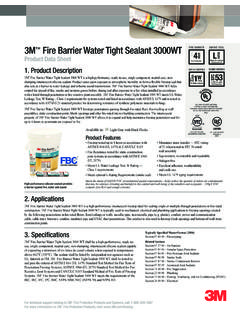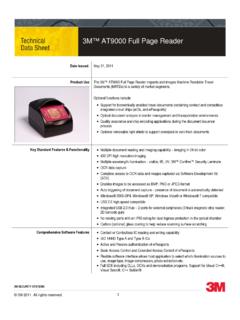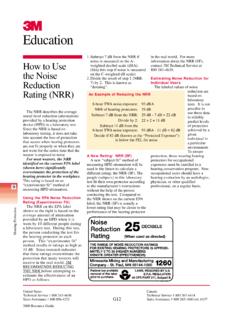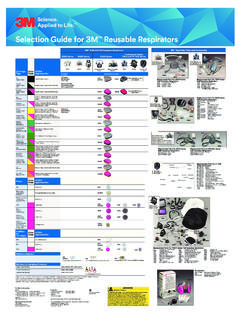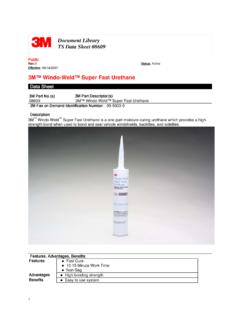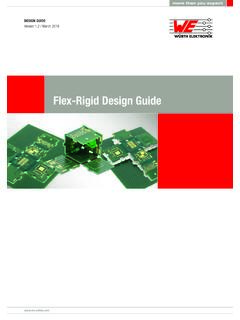Transcription of 3M Electrically Conductive Adhesive Transfer Tape 9703
1 Technical Data | October 20153M Electrically Conductive Adhesive Transfer Tape 9703 Product Description3M Electrically Conductive Adhesive Transfer Tape (ECATT) 9703 is a pressure sensitive Adhesive (PSA) Transfer tape with anisotropic electrical conductivity. The PSA matrix is filled with Conductive particles which allow interconnection between substrates through the Adhesive thickness (the Z-axis ) but are spaced far enough apart for the product to be Electrically insulating in the plane of the Adhesive . The PSA tack properties and lack of any thermal curing make 3M ECATT 9703 easy to use in assembly ECATT 9703 Electrically connects and mechanically bonds medium pitch flexible circuits with other flexible circuits ( flex ), rigid printed circuit boards (PCB) or LCD screens.
2 3M ECATT 9703 is Electrically Conductive and offers good adhesion to common PCB substrates such as copper, gold, FR-4 epoxy, DuPont Kapton polyimide and polyester films. Stable electrical performance in any flexible circuit interconnection application may require mechanical reinforcement (clamping).3M ECATT 9703 also Electrically connects and mechanically bonds EMI/RFI shield and gaskets to metal frames and enclosures. The low contact resistance and tape construction result in good EMI performance. 3M ECATT 9703 can be applied as die cut parts or in roll form and has good adhesion to common EMI/RFI substrates such as aluminum, stainless steel, and smooth gasket Construction Property Value Adhesive Type Filled Acrylic Pressure Sensitive Release Liner Silicone Treated Polycoated Kraft Paper Approximate Thickness Adhesive 2 mil (50 m) Liner 4 mil (100 m)(2)3M Electrically Conductive Adhesive Transfer Tape 9703 Peel Adhesion to Stainless Steel: Tested in accordance with a modified ASTM D3330 test method, 12 ipm peel rate, 1 in.
3 Width, 2 mil PET backing, 180 degree) Dwell Time @ Room Temperature 1 Hour 24 Hours 23 C 29 ( N/cm) 32 ( N/cm) Note: Peel values will often be higher than noted above when using a non-PET backing. Different backing types effect the backing modulus, thickness and stiffness and these differences directly effect the peel test result value. As an example, a 2 mil aluminum backing will change the test value of the peel adhesion as the peel back angle at the interface will change due to the backing stiffness. A 2 mil aluminum backing would generally increase the peel values. Temperature Performance1 Application Use Temperatures: -40 to +85 C in a properly designed end use application.
4 See Note 1. Application Storage Temperatures: See Shelf Life and Storage comments. End user needs to qualify converted material for a broader storage environmental range. See also the Application section of this document Outgassing: (NASA SP-R-0022 or ASTM E595) 125 C, 24 hrs, 2 x 10-6 Torr vacuum Total Mass Loss (TML) Collected Volatile Condensable Materials (CVCM) Properties: Insulation Resistance2,3 x 1014 ohms/square (estimated based on 3M Electrically Conductive Adhesive Transfer Tape 9703) Contact Resistance1 < ohms (3M Test Method, Gold PI flex onto Gold PCB, RT Initial R, 6 mm2) Minimum Gap4 15 mil ( mm) Minimum Overlap Area5 5000 mil2 ( mm2) Apparent Thermal Conductivity6 W/mKTypical Physical Properties and Performance CharacteristicsNote.
5 The following technical information and data should be considered representative or typical only and should not be used for specification Properties:1. The final assembly must be tested to verify that the 3M Electrically Conductive Adhesive Transfer Tape 9703 can achieve the desired performance in the assembly s end use application environmental conditions (temperature, humidity, temperature cycling, shock, application assembly design, assembly variation, etc.). 3M ECATT 9703 may achieve the -40 to +85 C temperature range (or broader temperature range excursions) in an end use application if the final assembly design is designed so that the Conductive particles remain in sufficient mechanical contact between surfaces to achieve the desired contact resistance.
6 Some type of mechanical bond line compression design as determined by the end use customer (clip, clamp, screw, compressed foam, etc.) that will apply a constant minimum pressure across the bond line may be required to meet the desired end use environmental ranges and contact resistance specification. The temperature use range is dictated by two primary items: Temperature performance of the acrylic Adhesive (generally in the range of -40 C to about 95 C depending on other environmental conditions) as it supports the Conductive particles in the Adhesive / particle matrix and the potential movement of the Conductive fillers in the Adhesive system in an end use application design.
7 Items contributing to the performance of the Tape 9703 for resistance level performance include, but are not limited to: assembled bond line force (constant force present across the bond line after assembly and over the life of the product), types of substrates bonding, surface features in bonded area, environmental conditions, (temperature, humidity, CTE, shock, environmental cycling, etc.), assembly surfaces and 3M ECATT 9703 compatibility, 3M ECATT 9703 filler and assembly surfaces galvanic potential compatibility, etc. (See section on mechanical clamping for added information).2. Tested in accordance with ASTM D-257 test Estimate based on 3M Electrically Conductive Adhesive Transfer Tape 9703 test Minimum free space between adjacent conductors suggested to ensure electrical isolation.
8 Customers may qualify finer pitch performance in their Minimum recommended conductor overlap area (pad area) in the interconnection of individual circuit lines to ensure Z-Axis Tested in accordance with a modified ASTM D5470 thermal test TechniquesBonding To obtain maximum adhesion, the bonding surfaces must be clean and dry. Pressure must be applied to the bond line after assembly to wet the substrates with 3M Electrically Conductive Adhesive Transfer Tape (ECATT) 9703 and to engage the Conductive particles with the substrates to make electrical connection. Mechanical pressure (roller, metal bar) or finger pressure at 15 psi ( Mpa) or greater is suggested.
9 Heat may be applied simultaneously to improve wetting and final bond strength. 3M ECATT 9703 should be applied between 60 F - 158 F (15 C - 70 C). Tape application below 50 F (10 C) is not recommended because the Adhesive will be too firm to wet the surface of the substrate, resulting in low adhesion. Adhesion builds with time, up to 24 hours may be required to reach final adhesion Clamping To assure electrical resistance stability of 3M ECATT 9703 in any flexible circuit interconnection application, a mechanical clamp or other compressive force ( foam strip held in compression over bond area.) should be considered in the design of the application.
10 Any stress inherent in the assembly design ( tensile, shear, cleavage) or temperature excursions (encountered through normal product use) applied to the bond area could result in an electrical open in the bonded circuit over time when no clamp or mechanism for maintaining a constant compressive forces is used. A well designed mechanical clamp will reduce the environmental stress on the bond line and improve the electrical reliability of the bond. In addition, the temperature operating range for the Adhesive can be improved with a properly designed mechanical clamping system to ensure the conducting particles in the 3M ECATT 9703 maintain electrical contact.
